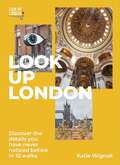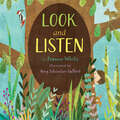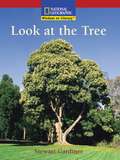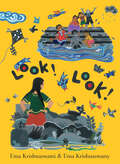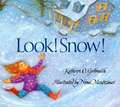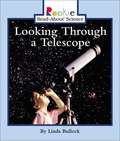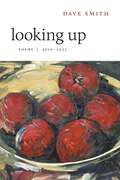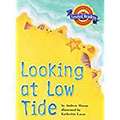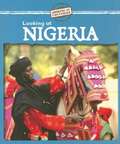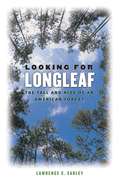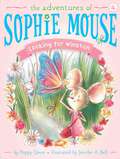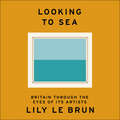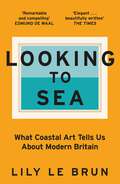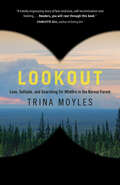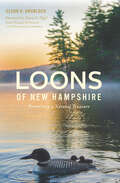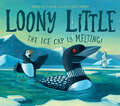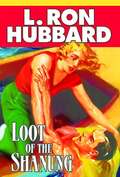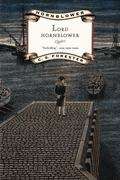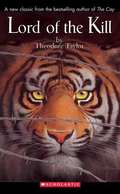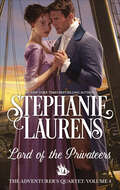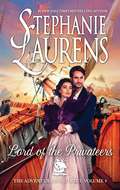- Table View
- List View
Look Up London: Discover the details you have never noticed before in 10 walks
by Katie WignallA refreshing guide to discovering the hidden details of London with 10 fully guided walking routes from London's leading tour guide Look Up London. Have you ever noticed London's tiniest public sculpture? Or wondered why there are strange cone-shaped structures on the fanciest historic homes? Did you know that the Tower of London used to be a zoo, or about the now defunct London railway that transported over 200,000 people to their final resting place? These are just some of the fascinating details that Blue Badge Tourist guide Katie Wignall reveals in this absorbing guide to the secrets of London hidden in plain sight. Take a journey through London's rich past with these 10 fully guided walking routes and discover a whole world of incredible history hiding above your eye-line, just waiting to be spotted. From the saucy scandals of Covent Garden to stories of power and intrigue from the City, atmospheric pubs to hidden Roman remains, London is a city bursting with captivating stories which are etched into its very architecture. So, Look Up and discover a London you have never seen before.
Look Up London: Discover the details you have never noticed before in 10 walks
by Katie WignallA refreshing guide to discovering the hidden details of London with 10 fully guided walking routes from London's leading tour guide Look Up London. Have you ever noticed London's tiniest public sculpture? Or wondered why there are strange cone-shaped structures on the fanciest historic homes? Did you know that the Tower of London used to be a zoo, or about the now defunct London railway that transported over 200,000 people to their final resting place? These are just some of the fascinating details that Blue Badge Tourist guide Katie Wignall reveals in this absorbing guide to the secrets of London hidden in plain sight. Take a journey through London's rich past with these 10 fully guided walking routes and discover a whole world of incredible history hiding above your eye-line, just waiting to be spotted. From the saucy scandals of Covent Garden to stories of power and intrigue from the City, atmospheric pubs to hidden Roman remains, London is a city bursting with captivating stories which are etched into its very architecture. So, Look Up and discover a London you have never seen before.
Look and Listen: Who's in the Garden, Meadow, Brook?
by Dianne WhiteA guessing game in a book that celebrates the curiosity and delight of a jaunt through a garden, meadow, and alongside a brook. A child steps outside and strolls along, taking in the sights and sounds of nature. Rhythmic, rhyming text tracks his journey through a garden, meadow, and next to a brook, introducing a new color and animal found in that ecosystem with every turn of the page, transforming an ordinary walk into a feast for the senses. Complete with material that explains the rich variety of wildlife and natural habitats found in the book, author Dianne White&’s playful text is paired with the vibrant collage artwork of Amy Schimler-Safford, making for an exciting read-aloud and guessing game for budding nature lovers.
Look at the Tree
by Stewart GardinerThis book points out different aspects of a tree that make it special.
Look to the Mountain: An Ecology of Indigenous Education
by Gregory CajeteAn important contribution to the body of indigenous cultural knowledge and a way to secure its continuance.
Look! Look!
by Uma KrishnaswamiA girl in India discovers an ancient step well in this companion book to the creators’ much-loved Out of the Way! Out of the Way! When a girl discovers a slab of stone on a weedy patch of land, she calls to her friends, “Look! Look!” The children clear away the weeds and garbage and find more stones. They call their families to come and see and begin to dig around the stones. Word travels to villages nearby, and more and more people join in, until the digging reveals steps that lead down to an ancient well. At the bottom, there’s even a little water! When the rains come, they cause an underground spring to flow once again, filling the ancient well with fresh, clean water and greening the surrounding fields. Lyrical writing and lively, richly colored art come together once again in this compelling story that embraces community, nature and the passage of time. Includes an author’s note about ancient step wells and their potential to help handle floods and provide water. Key Text Features illustrations author’s note Correlates to the Common Core State Standards in English Language Arts: CCSS.ELA-LITERACY.RL.K.6 With prompting and support, name the author and illustrator of a story and define the role of each in telling the story. CCSS.ELA-LITERACY.RL.K.7 With prompting and support, describe the relationship between illustrations and the story in which they appear (e.g., what moment in a story an illustration depicts). CCSS.ELA-LITERACY.RL.1.3 Describe characters, settings, and major events in a story, using key details.
Look! Snow!
by Kathryn O. GalbraithThe first snow of the season brings great enjoyment to the town's human and animal inhabitants.
Looking Through A Telescope (Rookie Read-About Science)
by Linda Bullock"Simple text and photographs describe and illustrate how to use a telescope." Other books in this series are available in this library.
Looking Up: Poems, 2010–2022
by Dave SmithLooking Up collects more than a decade of new poems by Dave Smith. These include reflections upon events, animals, and people who prove to have a salutary significance to this poet, now approaching his eightieth year. He ponders the substantial changes wrought by retirement, which brings no expectations, no obligations, no role beyond what one has left, which prompts the question, What will you do now? Both the question and its answers are the subject of Looking Up, as Smith gives us poems as acts of attention, raptures, comedies, sardonic narratives, vignettes of grief and joy whose testimony shows that love is surely our core reality.
Looking at Low Tide (Houghton Mifflin Reading Leveled Readers)
by Andrew MasonThis story is about a vacation at the beach.
Looking at Nigeria (Looking at Countries)
by Jillian PowellIntroduces Nigeria, including the geography, people, education, rural and urban life, housing, food, work, and amusements, and provides other information about the country.
Looking for Longleaf
by Lawrence S. EarleyCovering 92 million acres from Virginia to Texas, the longleaf pine ecosystem was, in its prime, one of the most extensive and biologically diverse ecosystems in North America. Today these magnificent forests have declined to a fraction of their original extent, threatening such species as the gopher tortoise, the red-cockaded woodpecker, and the Venus fly-trap. Conservationists have proclaimed longleaf restoration a major goal, but has it come too late?In Looking for Longleaf, Lawrence S. Earley explores the history of these forests and the astonishing biodiversity of the longleaf ecosystem, drawing on extensive research and telling the story through first-person travel accounts and interviews with foresters, ecologists, biologists, botanists, and landowners. For centuries, these vast grass-covered forests provided pasture for large cattle herds, in addition to serving as the world's greatest source of naval stores. They sustained the exploitative turpentine and lumber industries until nearly all of the virgin longleaf had vanished. Looking for Longleaf demonstrates how, in the twentieth century, forest managers and ecologists struggled to understand the special demands of longleaf and to halt its overall decline. The compelling story Earley tells here offers hope that with continued human commitment, the longleaf pine might not just survive, but once again thrive.Covering 92 million acres from Virginia to Texas, the longleaf pine ecosystem was, in its prime, one of the most extensive and biologically diverse ecosystems in North America. Today these magnificent forests have declined to a fraction of their original extent, threatening such species as the gopher tortoise, the red-cockaded woodpecker, and the Venus fly-trap. Lawrence S. Earley explores the history of these forests and the astonishing biodiversity within them, drawing on extensive research and telling the story through first-person travel accounts and interviews with foresters, ecologists, biologists, botanists, and landowners. The compelling story Earley tells here offers hope that with continued human commitment, the longleaf pine might not just survive, but once again thrive.-->
Looking for Trouble (Camp Sunnyside Friends #5)
by Marilyn KayeErin thinks her interests are different from her cabin-mates, but when she takes part in prohibited activities of the older girls in cabin nine, she finds out who are her real friends.
Looking for Winston (The Adventures of Sophie Mouse #4)
by Poppy GreenSophie Mouse’s little brother goes missing in the fourth book of The Adventures of Sophie Mouse.Sophie’s brother Winston really wants to help Sophie and her friends build a fort at Butterfly Brook. But Sophie doesn’t want her six-year-old brother hanging around, and she tells him he’s too little to join. Soon after Winston leaves, Sophie realizes that they could use his help after all. So she returns to tell Winston he’s welcome to come along—but Winston is nowhere to be found! Will Sophie find her little brother?With easy-to-read language and illustrations on almost every page, the Adventures of Sophie Mouse chapter books are perfect for beginning readers.
Looking to Sea: Britain Through the Eyes of its Artists
by Lily Le BrunLooking to Sea is an alternative history of Britain in the twentieth century, told through the prism of ten iconic artworks of the sea, one for each decade.'We see nothing truly until we understand it.' John ConstableAn alternative history of Britain in the twentieth century, Looking to Sea is an exquisite work of cultural, artistic and philosophical history.From Vanessa Bell's Studland Beach, one of the first modernist paintings in Britain, to Paul Nash's work bearing the scars of his experience in the trenches and Martin Parr's photographs of seaside resorts in the 1980s that tackle ideas of class and deprivation, Looking to Sea embraces ideas from modernism and the sublime, the impact of the world wars and colonialism, to issues crucial to our world today like the environment and nationhood.Looking to Sea is an astonishingly perceptive portrait of the twentieth century. Art critic Lily Le Brun brings a fresh eye, acute observation and challenges the reader to find a new way to look at the history of our island nation.'Looking to Sea is a remarkable and compelling book. It is both a wonderfully sustained mapping of the intersection between artists, writers and the sea and a meditation on belonging and displacement. I loved it.' Edmund de Waal(P) 2022 Hodder & Stoughton Limited
Looking to Sea: Britain Through the Eyes of its Artists
by Lily Le Brun*One of The Times Best Art Books of the Year*'Looking to Sea is a remarkable and compelling book... I loved it.' Edmund de Waal'In her first, transporting book, Lily Le Brun sweeps the beaches of the past century of British art, collecting treasures from sea, shingle and shore... A book to pack in your picnic basket for shivering dips, heatwave day trips and ice-cream Sundays' The TimesAn alternative history of modern Britain, Looking to Sea is an exquisite work of cultural, artistic and philosophical storytelling. Looking to Sea considers ten pivotal artworks, from Vanessa Bell's Studland Beach, one of the first modernist paintings in Britain, to Paul Nash's work bearing the scars of his experience in the trenches and Martin Parr's photographs of seaside resorts in the 1980s, which raised controversial questions of class. Each of the startlingly different pieces, created between 1912 and 2015, opens a window onto big ideas, from modernism and the sublime, the impact of the world wars and colonialism, to issues crucial to our world today like the environment and nationhood. In this astonishingly perceptive portrait of the twentieth century, art critic Lily Le Brun brings a fresh eye to a vast idea, offering readers an imaginative new way of seeing our island nation.'Le Brun's writing is at once bold and delicate, far-reaching and fine-tuned. Her book explores the inexhaustible variety of human perception.' Alexandra Harris'A smart and clear-eyed set of meditations on marine gaze, made with a painterly touch worthy of the chosen artists. Empathy and intelligence lift memoir into cultural history.' Iain Sinclair'Elegant and endlessly interesting . . . as much a rich compendium of social history as it is a hard consideration of art itself' Critic
Lookout: Love, Solitude, and Searching for Wildfire in the Boreal Forest
by Trina MoylesA page-turning memoir about a young woman's grueling, revelatory summers working alone in a remote lookout tower and her eyewitness account of the increasingly unpredictable nature of wildfire in the Canadian north.While growing up in Peace River, Alberta, Trina Moyles heard many stories of Lookout Observers--strange, eccentric types who spent five-month summers alone, climbing 100-foot high towers and watching for signs of fire in the surrounding boreal forest. How could you isolate yourself for that long? she wondered. "I could never do it," she told herself. Craving a deeper sense of purpose, she left northern Alberta to pursue a decade-long career in global humanitarian work. After three years in East Africa, and newly engaged, Trina returned to Peace River with a plan to sponsor her fiance, Akello's, immigration to Canada. Despite her fear of being alone in the woods, she applied for a seasonal lookout position and got the job. Thus begins Trina's first summer as one of a handful of lookouts scattered throughout Alberta, with only a farm dog, Holly--labeled "a domesticated wolf" by her former owners--to keep her company. While searching for smoke, Trina unravels under the pressure of a long-distance relationship--and a dawning awareness of the environmental crisis that climate change is producing in the boreal. Through megafires, lightning storms, and stunning encounters with wildlife, she learns to survive at the fire tower by forging deep connections with nature and with an extraordinary community of people dedicated to wildfire detection and combat. In isolation, she discovers a kind of self-awareness--and freedom--that only solitude can deliver. Lookout is a riveting story of loss, transformation, and belonging to oneself, layered with an eyewitness account of the destructive and regenerative power of wildfire in our northern forests.
Loons of New Hampshire: Preserving a Natural Treasure (Natural History)
by Glenn A. KnoblockNoted for its stunning plumage and haunting cries, the common loon is an iconic symbol of nature in the Granite State. Once a familiar site on local ponds and lakes, by the early twentieth century their numbers had dwindled due to human activity. By the 1970s less than two hundred remained. It was only with the formation of the Loon Preservation Committee in 1975 by pioneer conservationist Rawson Wood that the plight of loons in New Hampshire changed for the better. Author Glenn Knoblock, in collaboration with leading experts from the organization, reveals the sometimes-mysterious nature of this beloved bird, its presence throughout the state's history, the threats it faces today and the extensive efforts to recover the population. The Loon Preservation Committee is the only organization in New Hampshire working directly on their behalf. A portion of the proceeds of the sales of this book will go directly to the organization to fund ongoing conservation efforts.
Loony Little: The Ice Cap Is Melting
by Dianna Hutts AstonCelebrate the 50th anniversary of Earth Day with this clever, climate-focused twist on the classic "Chicken Little" story.Loony Little and her friends set off to tell the Polar Bear Queen that the polar ice cap is melting. Sly Foxy Loxy attempts to lead the animals to his lair to eat them, but Loony Little saves the day, tricking the fox into being devoured by the Polar Bear Queen. Includes information about climate change and the animal species in the book.
Loop de Loop: Circular Solutions for a Waste-Free World
by Andrea CurtisGet loopy with this playful introduction to the hopeful, transformative possibilities of circular systems! Nature works on a cycle, where everything in the loop has value and nothing is wasted. But modern humans have created a different kind of system: it’s less like a circle and more like a line. We take, make, use and then, when those things break or we’re finished with them, we toss them away. But our planet’s resources are limited, and we’ve taken too much. That’s why all over the world, people are reusing, repurposing, repairing and designing waste out of the system! Explore the ways that people everywhere are creating a loopier world: from growing building materials out of fungi to designing headphones (and cellphones!) that last, to producing vehicles that run on renewable energy. Plus, kids and families have a role to play, too. Loop de Loop introduces young readers to repair cafés, toy rentals, tool libraries and many more fun, innovative ways to build community and a more sustainable world. Includes a list of ways children can take part in circular systems, along with a glossary and sources for further reading. Key Text Features Illustrations glossary definitions further reading Correlates to the Common Core State Standards in English Language Arts: CCSS.ELA-LITERACY.RI.K.8 With prompting and support, identify the reasons an author gives to support points in a text. CCSS.ELA-LITERACY.RI.1.2 Identify the main topic and retell key details of a text.
Loot of the Shanung
by L. Ron HubbardStop the presses! One hundred thousand dollar reward offered for the return of George Harley Rockham! That's more than enough to turn Shanghai newspaperman Jimmy Vance's head. Throw in the gorgeous dame who's offering the reward--Rockham's daughter Virginia--and he might lose his head altogether. As fast-talking as Jimmy Stewart in The Philadelphia Story, Vance jumps at the chance . . . the money . . . and the girl.But as Jimmy quickly discovers, there are several billion reasons to watch his back. Because that's how much Rockham is worth, and there are some very hard cases out there willing to kill to separate the old man from his money.Next thing Jimmy knows, Virginia's tied to a chair, and he's got a couple of guns pointed at his head. But it'll take more than a little rope and a couple of firearms to keep this reporter down. The truth is tied to the mysterious fate of a steamship named Shanung--and what Jimmy finds could be the biggest story of his life . . . if he lives to tell it. In the issue of Smashing Novels where this story first appeared the editor wrote: "Loot of the Shanung is a soul-stirring tale of the China Sea, a story of modern piracy set in the Far East. L. Ron Hubbard wrote it. He knows China. He has been there. He traveled through the country and met the people and observed their customs. Smashing Novels will have other stories from him--stories of far-off places and little known people. He knows of what he writes."
Lord Hornblower (The Hornblower Saga, Book #5)
by C. S. ForesterThese thrilling tales of high-seas adventure in the Napoleonic era, which Winston Churchill found "vastly entertaining" and Ernest Hemingway recommended to "every literate I know", are being eagerly embraced by a new generation of readers.
Lord of the Kill
by Theodore TaylorWhen a half-eaten body is found inside a jaguar cage, eighteen-year-old Ben Jepson knows it's no prank - someone's trying to make trouble for the Los Coyotes Big Cat Preserve and its manager, Ben's father. Dr. Jepson has made some powerful enemies in his tiger conservation mission deep in the jungle and now Ben is the only one who can keep Los Coyotes running. When his beloved tiger Dmitri, is kidnapped, Ben must decide whether to wait for the authorities or to strike out on his own.
Lord of the Privateers (The Adventurer's Quartet #4)
by Stephanie LaurensThe thrilling conclusion to the #1 New York Times–bestselling author’s sexy and swashbuckling Regency romance series.Known as the lord of the privateers, Royd Frobisher is determined to finish the high seas rescue mission his younger brothers began. But his daring plan doesn’t account for Isobel Carmichael—his emotional nemesis, childhood sweetheart, ex-handfasted bride, and current business partner—coming along.Isobel has a mission of her own—find her cousin Katherine and bring her safely home. Along the way, she hopes to rid herself of the lingering desire for Royd that still haunt her. As their adventure takes them from the high seas to sweltering jungles and the glittering ballrooms of Mayfair, they are drawn once again to the flame of undeniable passion. But having glimpsed the future that could be theirs, they must finally ask what they are willing to risk in the name of duty . . .
Lord of the Privateers (The Adventurers Quartet)
by Stephanie LaurensCan true love die? Or, neglected, does it lie dormant until the object of true desire is again within reach? Denied, does passion smolder, like embers waiting for the right conditions to flare into an all-consuming conflagration? <P><P> #1 New York Times bestselling author Stephanie Laurens delivers the thrilling conclusion to her acclaimed series, THE ADVENTURERS QUARTET, a passionate Regency-era drama played out on the high seas and in the sweltering heat of tropical jungles, ultimately reaching a scintillating climax in the glittering ballrooms of Mayfair.<P> The eldest of the Frobisher brothers and widely known as the lord of the privateers, Royd Frobisher expects to execute the final leg of the rescue mission his brothers have been pursuing. What he does not expect is to be pressured into taking his emotional nemesis, childhood sweetheart, ex-handfasted bride, and current business partner, Isobel Carmichael, with him. But is it Isobel doing the pressuring, or his own restless unfulfilled psyche?<P> Resolute, determined, and an all but unstoppable force of nature, Isobel has a mission of her own—find her cousin Katherine and bring her safely home. And if, along the way, she can rid herself of the lingering dreams of a life with Royd that still haunt her, well and good.<P> Neither expects the shock that awaits them as they set sail aboard Royd's ship, much less the new horizons that open before them as they call into London, then, armed with the necessary orders and all arrangements in place, embark on a full-scale rescue-assault on the mining compound buried in the jungle.<P> Yet even with the support of his brothers and their ladies and, once rescued, all the ex-captives, Royd and Isobel discover that freeing the captives is only half the battle. In order to identify and convict the backers behind the illicit enterprise—and protect the government from catastrophic destabilization—they must return to the ballrooms of the haut ton, and with the help of a small army of supporters, hunt the villains on their home ground.<P> But having found each other again, having glimpsed the heaven that could be theirs again, how much are they willing to risk in the name of duty?<P> Learn the answer and revel in the action, drama, intrigue, and passion as the Frobishers—with help from Wolverstone, the Cynsters, and many familiar others—steer the adventure to a glorious end. <P><b>A New York Times Bestseller</b>
